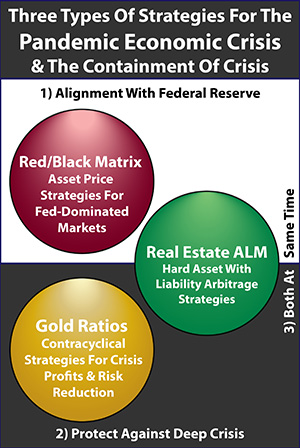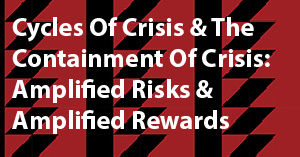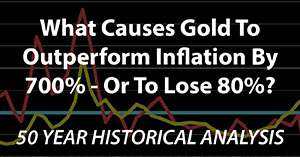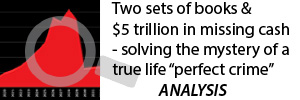Climate Change & Court-Ordered Inflation
By Daniel R. Amerman, CFA
TweetA Dutch court has found an oil company, Shell, to be partially responsible for causing climate change, and has ordered Shell to reduce carbon emissions by 45% by 2030. Crucially, the 45% reduction is not just for Shell's own emissions, but the emissions caused by the use of its petroleum products on a global basis, by the consumers and companies of the world.
The attorneys and environmental activists involved are jubilant, and are hoping to use the case as a precedent for similar court decrees in other nations. There is also talk of using similar lawsuits to force the transformations of the agricultural, transportation and mining industries, due to their own emissions and purported contributions to global warming.
There are obviously extraordinary environmental, scientific and political issues involved - but we won't be going there in this analysis. We will be sticking to the potential financial implications. Those implications are huge, and could indeed end up dominating the financial markets of the 2020s. This could be called simple common sense - an unprecedented change in the very basics of how our global civilization functions will of course have extraordinary financial implications, there will be no getting away from it. Specifically, if this decree is upheld on appeal, and if it does create precedents for similar actions by other courts in potentially multiple industries, then as developed in this analysis, there is a strong chance that these actions will artificially induce persistent and major supply side inflation on a global basis over the coming decades.
The court-ordered inflation would set off a mathematical process of the destruction of wealth and standard of living for those who are not prepared. At the same time, the court order could set off an unusually reliable mathematical process for the creation of wealth, for those who thoroughly understand how to turn inflation into wealth. This is particularly true if supply side inflation merges with the separate force of money creation inflation at some point.
This analysis is part of a series of related analyses, which support a book that is in the process of being written. Some key chapters from the book and an overview of the series are linked here.
Supply Side Inflation Shocks
In the previous analysis linked here, a series of supply side inflation shocks that are currently hitting the U.S. economy were identified. This is an entirely different kind of inflation than the type of inflation that can be created by excessive money creation, but as explored in that analysis, the two types of inflation can merge in a multiplicative fashion, that is more powerful and more persistent than just the sum of the parts.
One of the key distinctions in that analysis was the difference between the transitory and the structural. The establishment response to sharply rising inflation in multiple categories is that it is transitory, a temporary condition existing because of the supply shortages that were created by the pandemic shutdowns. As the shutdowns cease, then the supply shortages should cease, and the inflation should end - or so the talking points go.
However, the order by the Dutch court in the Hague on Wednesday, May 26, 2021, is intended to be the direct opposite of transitory, indeed the intent is to force a permanent change in energy usage for wherever Shell's products are sold and used.
While this particular use of judicial power was previously unprecedented, it didn't happen in isolation. The rationale for the 45% reduction order was to force Shell to be in compliance with United Nations guidelines and the Paris Agreement. There are extremely powerful political forces in alignment with the judicial decision, and this is intended to move the enforcement of the Agreement and the UN guidelines to the courts and attorneys, instead of the unpredictability of voters, elections, legislatures and the democratic process.
If the decision holds, then there is no particular reason to believe that it will be restricted to just Shell, or to just oil companies. Once the reason for the decision is accepted, then it is entirely rational to believe that it will be extended to other major emissions producers, including the agriculture and transportation industries, as well as manufacturing and perhaps home building as well.
The current discussion is that the main implications at this stage are for European companies, with the decisions of the other courts in Europe being more likely to be influenced by the decision of the Dutch court. This means that consumers and businesses in the United States are most likely to be directly impacted as the numerous multinational corporations that are headquartered in Europe are potentially ordered to make changes.
That said, a globalized economy is subject to judicial controls on a global basis. At the least, there is a good chance that the European operations of U.S. multinationals will be under court orders to reduce their emissions. It is also possible - perhaps even likely - that an attempt will be made to make the court orders global for any company doing business in Europe.
It is also possible that any such attempt might find willing support from the current U.S. government and at least some federal judges. What the Dutch court is ordering is in exact political alignment with what many U.S. politicians and government officials believe as well. We may very well have federal judges in the U.S. opening up new areas of law, and expanding their judicial powers in this process.
It is, of course, far too early to say the full extent of how this will impact U.S. consumers as well as others around the world. But a door has been opened, one of judicial decrees that mandate the achievement of global environmental goals. If this first decree is upheld and reinforced, other judicial orders like it could indeed spread to include not just fossil fuels, but also food, transportation, and possibly many other aspects of day to day life.
Mandated, Relentless Inflation On A Schedule
Restricting this analysis to the financial and economic implications, the issue is that the world predominately runs on fossil fuels for a reason - they are relatively cheap and relatively plentiful. At least at this point, the alternatives are more expensive, and less plentiful. It is more expensive to build an electric vehicle, all else being equal. The rare earths for the batteries that power the electric vehicles are not at this stage as globally abundant as petroleum, and are quite reliant on Chinese extraction and refinement. The alternative sources of power for the electric grid, such as solar and wind power, are expensive to build, they aren't always online, and they are therefore more expensive and less reliable sources of energy than fossil fuels.
In other words, the impact of the court order is that on average anything that uses energy becomes more expensive every year, as an increasing percentage of the source of cheap energy is withdrawn, and is replaced with more expensive but more environmentally friendly sources of energy. If this weren't true - there wouldn't be any need for the judicial decrees or the extensive government financial support of alternative energy, the markets would instead take care of the transition.
The decree of the district court in the Hague introduces a brand new and very powerful factor to the financial world. The practical economic impact is powerful and relentless supply side inflation - on a judicially imposed schedule, that is at least partially known in advance.
The court did not provide the year by year specifics, just that the 45% reduction goal in 9 years must be met, and that there must be annual progress in meeting that goal. Indeed, that was the reasoning for the decree, which wasn't that Shell was currently out of compliance, but that it was likely to go out of compliance in the near future.
One path to reducing emissions by 45% over 9 years is to knock off 5% in each year compared to the starting point. This would be a 5% reduction in the first year, and an 8.3% reduction in the last year (5% / 60% = 8.3%). Because the reductions are likely to be more difficult to achieve in each successive year, as the easier reductions get used up first, this would be an extremely difficult path.
A more consistent approach would be to reduce emissions by about 6.5% per year, which would lead to 55% of the emissions after 9 years ((100% - 6.43%) ^ 9 = 55%).
If we expand beyond just Shell and include the other major fossil fuel energy companies, whether the source of the orders is just Europe, or is Europe and the U.S. in combination, then we have an extremely aggressive schedule to meet. Through some combination of A) greater efficiencies; B) energy source replacement; and C) just plain reducing supply while creating shortages; emissions would need to come down by 6.5% a year, every year, for the remainder of the 2020s.
As analysts and financial reporters struggle with how to process the brand new, some of the initial focus is on Shell just selling assets each year to reduce their share of global carbon dioxide emissions. That could happen initially, but that is also more or less missing the point entirely. If divestitures don't reduce global emissions, then they are worthless, and the point of the action by the Dutch court was to force real global change on a mandatory timeline. If this continues, then the divestiture loophole will likely close, and that is if it even exists right now.
How much will the price of energy rise in each year? Nobody knows, and that is more or less the reason for imposing the controls via lawsuits and courts, rather than elections and legislatures. The impacts on prices or the lives of voters or individual standards of living were irrelevant to the court, all that mattered was meeting the UN and Paris Agreement goals, as a matter of overarching international law.
Just to have a number to work with, let's say that the cost of energy rises at the same rate at which the emissions are reduced, so that a 6.5% reduction in emissions leads to a 6.5% increase in energy costs. I think that's probably a very conservative estimate, it is more likely to be 10%+ in the early years, and then grow still higher in each passing year as the emissions reductions get harder and harder to achieve.
Keep in mind that substantially increasing efficiencies each year is expensive and difficult, and quickly bringing vast new alternative energy sources online is also expensive and difficult. The backstop, and by far the easiest and most reliable way to meet the non-negotiable judicial order is to just sell 6.5% less oil and gas each year. This artificially induced shortage creates supply side inflation, with energy prices that may jump up much faster than a mere 6.5% per year.
Multiplying The Price Increases
As long time readers know, I have spent many years analyzing the actual data, the long term historical numbers for inflation and the performance of inflation hedges such as gold, stocks and housing. The historical mathematical relationships are in fact quite different than the popular perceptions of many long time precious metals and housing investors. For natural reasons, too many people focus on the negative, the destruction of the value of the dollar, and they miss the potential positive investment implications of inflation being a series of multiplications of the numbers of dollars, not a destruction of dollars. There are increases in dollars that can be arising from multiple sources, and they can multiply times each other.
Indeed, the real history of the housing market and real estate investment on a national average basis depends on understanding how to exploit the multiplications that are the results of deliberate government policies of inducing low to moderate rates of inflation each year, as discussed in the book chapter linked here. If we have government based inflation that flows not from the central bank but the judiciary, and it is at a higher rate than what the Fed or ECB desires, then we have a much more powerful mathematical formula for turning that reliable inflation into reliable wealth.
On the simplest level, the first level of inflation is the increase in the number of dollars that it takes each year to buy energy, whether it be gasoline, or natural gas, or the cost of a kilowatt hour of electricity. The second level is to multiply each year's increase by the previous year's multiplication. Nine straight years of 6.5% inflation increases energy prices by 76%, while nine years of 10% inflation increases energy prices by 136%, and nine years of 15% inflation increases energy prices by 252%.
The 59% increase in gasoline prices over the last 12 months would not be transitory but the permanent base for far higher prices. Over time the much higher prices and shorter supplies would greatly reduce the miles driven by gasoline powered vehicles - and that's the idea, the goal, the reason for the court order. Fewer people would own their own vehicles - that is the idea as well. The more expensive electric cars would be owned by a smaller percentage of the population, and a greater percentage of the low income population would grow up never owning a car - and that's the idea too, the plan.
The price increases would not be constrained to direct energy use. Once it gets going, inflation always wants to go forth and multiply, and then multiply again, it is the nature of the beast.
Even without direct judicial decrees, the cost of food goes up because the cost of energy goes up, and it takes a lot of energy to produce food.
The cost of everything that needs to be transported goes up as well, and this applies not just to gasoline, but to the charges involved in transporting the goods when using electric vehicles.
In a grocery store, the cost of buying the food from the agricultural producers is up, the cost of transporting the food to the store is up, the cost of transporting the customer to the store (or the delivery driver to the customer) is up, and the cost of keeping the lights on and the refrigerators and freezers operational goes up as well. All of this combines to produce potentially sharply higher grocery prices, year after year, as the fossil fuel spigot is shut down another notch each year.
Now some people might think what is described above sounds pretty awful, others might think it is exactly what the world needs. Again, that's the point of judicial decrees based on international law, since it won't necessarily matter what we think.
The average customer is going to need more money, each year, to maintain what is likely to be even a slowly falling standard of living. The average grocery store clerk is also going to need more money each year, as are the farmers and the drivers.
A wage-based inflationary cycle kicks in to accompany the court-ordered supply side inflation shocks. Rising wages increase costs, even as supply side costs are going up as well, the combination means that wages have to go up again, and that then further increases costs.
The average rate of inflation was 1.58% in 1965, the last year of the relatively low era of inflation that had prevailed since 1952. The rate of inflation almost doubled in 1966, as the growing costs of the Vietnam War helped to set in motion the slow collapse of the Bretton Woods accord, thereby severing the last link between the U.S. dollar and the price of gold. Over the next 31 years the annual rate of inflation would drop below 2% only once. Indeed it took 13 years after the 13.50% inflationary peak of 1980, before annual rates of inflation reached levels that were fairly consistently below 3%.
The lessons of history are very clear - once inflationary cycles get going, and inflationary expectations get built into the decision making processes of workers and businesses, then it is a very difficult, long term process to try to break out of those inflationary cycles.
A Potentially Unsolvable Problem
The Federal Reserve has taken to talking a good game about how easily they can control inflation if they have to. One technicality to keep in mind however, is that for most current economists - this is all theory. The last time the Fed had to confront an official annual rate of inflation above 4% was in 1991. There have been huge changes in the economy since that time, as it has become globalized even while the nature of the U.S. dollar has changed with the introduction of reserves-based monetary creation to fund quantitative easings.
There is one type of inflation that the Fed has never had control over, and that is as covered in the previous analysis, inflation that is caused by shortages and supply side shocks. To fix that kind of inflation requires fixing the physical shortage problem.
We're seeing this right now with the 12 month increase in the prices of imports going up by 10.6%. The Federal Reserve doesn't have any magic monetary wand to wave that will make those inflationary price increases go away - either the shortages and supply bottlenecks that are driving the increase in prices are physically solved, or else we have price inflation, there is little the Fed can do about that.
If we have a temporary surge in inflation caused by shortages that has spilled over into more general rising price levels, and the shortages all end, then in theory the Fed should be able to dampen that inflation within a year or two, bringing the secondary sources of inflation back under control. In theory.
However, if inflation is caused by court-ordered reductions in emissions over the period of a number of years, then there may be an inflation problem that is completely beyond the control of the Federal Reserve or any other central bank.
In year one, shortages and an ever heavier reliance on more expensive energy alternatives means rising prices for energy, that spills over into wages and the costs for goods produced with energy. The Fed can do nothing about the primary increase in the cost of energy, but it can try to reduce the secondary effects, to try to keep an inflationary cycle from being built into wages and goods that require energy to produce or transport.
Just as the Federal Reserve and European Central Bank are struggling with containing the inflation damage from year one, then year two rolls around, the supply of fossil fuels drops by another 6.5%, and this energy is less than fully replaced by more environmentally friendly but more expensive alternatives. The greater shortages and greater price increases create a second major primary energy inflation shock, that the Fed is powerless to prevent.
This second primary inflation shock hits the secondary inflation from the first primary inflation shock, which the Fed has not yet contained - and it reinforces the pressures on wages, and the price pressures on goods that require a substantial amount of energy usage. Prices for goods increase substantially, wages move up substantially, and the increase in wages then makes goods that much more expensive to make. Instead of dampening, the inflationary cycle strengthens, and becomes more resistant to attempts by the Federal Reserve to control it.
Even as the Fed struggles to maintain some level of control, year three and the third primary energy inflation shock hits the nation - right on schedule, per the order of the courts. The use of fossil fuels is down another 6.5% in another single year, the cost of energy surges again for the entire nation, the prices for goods made with energy surge again, and wages surge again, in the attempt to keep up. (For those without wages or the ability to keep up with inflation, such as with retirees, this is where the damage is really mounting up - fast.)
By this stage, a new inflationary cycle may be fully established. Even without further primary energy inflation shocks, companies, workers and consumers are now anticipating inflation and are fully building substantial inflationary expectations into their economic behavior and pricing decisions. The changes in inflation expectations and behavior will have spread throughout the economy, and will not be solely dependent on energy price increases.
This isn't just theory, but it is our collective history. This persistent and difficult to overcome type of inflation was what was happening in real time when I was studying economics in college and graduate school in the late 1970s and early 1980s. However, in some ways it seems almost like lost knowledge for many today, who are focused on the easier to understand concept of inflation that is created by excess money creation. What happened in practice was a different source of rising prices. The last time this happened it took decades to fully break the inflationary cycle.
The fact is that we know what the highest levels of inflation of our lifetimes looked like, we know what produced the largest precious metals profits and housing profits we have seen to date - and it wasn't money printing. Indeed, when we study the actual historical data rather than reinforcing confirmation bias with regard to theories about how gold is supposed to work, then what produced the largest gold profits we have seen was gold reacting to inflation in a quite different way than many precious metals investors seem to understand today, as explored in Chapter 16 (link here), and then further developed in subsequent chapters.
However, the 1970s and 1980s did not have the force of law dictating that the shortages and the price of energy would relentlessly increase each and every year. This would be something that we have never seen before, and it is a problem that our central banking systems in the U.S., Europe and other nations simply do not have the tools to deal with.
Just by itself the further substantial reductions in emissions ordered for each successive year will create a powerful primary inflationary surge that will reinforce itself over time, with each year of price increases multiplying times the previous years of price increases.
What will happen when businesses, consumers and workers don't just anticipate likely price increases next year and the year after, but are reading in the media about the judicial decrees that mandate steadily increasing supply shortages that will stretch out many years into the future? We can't say for sure at this point, new textbooks will be written about it (if it happens), but based on what we do know from the past, the changes in behavior could set off a self-reinforcing inflationary cycle that could make the 1970s and 1980s look like a walk in the park in comparison.
Inflation Source Multiplication
Entirely separately - we do have the problem of a U.S. economy that is dependent on the Federal Reserve buying trillions of dollars of government debt, thereby funding the governmental stimulus spending. It is not yet true money printing at this stage, but involves the use of the reserves-based money creation that was first used in 2008. As explored in the analysis linked here, there are only limited supplies for this type of money creation, and if those are exhausted, then we could indeed face the choice between financial collapse, or straight up pure money creation to fund government spending, something that would likely very quickly lead to high rates of inflation.
The Biden administration has now proposed a $6 trillion federal government budget, that even after the huge tax increases, would still add new federal debt at a rate of a little under $2 trillion per year. That could place enormous strains on a Federal Reserve that is already under acute pressure, as explored in the analysis linked here, with the Fed going through major gyrations earlier in 2021 just to keep the national debt funded while providing the Treasury with its spending money.
Growing a national debt by more in 2020 on an inflation-adjusted basis than it had grown in the first 200 years of existence for the United States is risky business, and the Federal Reserve being the primary source of funds makes it that much riskier. Future high rates of inflation are a very good possibility as a result, and there is just no getting around that basic relationship.
Also entirely separately, as explored in the previous analysis, we currently have the highest rates of inflation that have been seen in the U.S. in many years - in multiple areas. Import prices are up by 10.6% in 12 months, gasoline prices are up by almost 50%, used car prices are up by 21%, and home prices are up by almost 13%. These price increases are not from judicial decrees or money printing, but an entirely different source, that of shortages and supply side inflation shocks. They may prove transitory - or they may not, and if they persist, they could be enough to create a new inflationary cycle by themselves, particularly if a potentially declining U.S. dollar creates persistent import price inflation.
We can't know the exact path ahead for judicial orders, executive actions and legislative changes when it comes to carbon dioxide emissions and climate change. We do know that the Paris Agreement is in place and the U.S. is again a participant, pledging it will do its share when it comes to reducing emissions. We do know that there are enormously powerful political, legal and corporate forces in place, both domestically and internationally, that have pledged to radically reduce emissions over the next decade. And as of last week, we now have direct judicial action, with a court in the Hague ordering Shell to reduce all emissions produced by its products by 45% in nine years, as a matter of international law.
Those are three separate sources of potential future inflation. Any one of them could be enough by themselves to substantially raise inflation rates. Each by itself has the potential for creating a self-reinforcing inflationary cycle, of the type that dominated the 1970s and 1980s.
If we get any two of those inflationary sources at the same time - then we get a multiplication of two primary sources of inflationary power. We also get a multiplication of the secondary sources, with wages and costs of goods and services all rising together, feeding each other, with a substantially greater likelihood of creating a powerful self-reinforcing inflationary cycle that is very difficult to break.
If we get all three sources of inflation together - then our lives change, and this could happen very quickly.
One of the most important aspects of higher rates of inflation that seems to have mainly been forgotten is that inflation teaches people and people adapt. High rates of inflation teach people through inflicting financial pain. Companies get burned when they take losses on fixed contracts because their cost of supplies and labor rises, and they adapt. Wage earners get burned when their standards of living are reduced, and they adapt, doing everything they can to prevent future losses. Underlying everything else, that is where the self-reinforcing inflationary cycles come from, it is from companies and people learning painful lessons, and then changing their behavior to try to protect themselves from any future financial pain from inflation.
The worst of the damage, particularly at the beginning of a new secular cycle of inflation, is reserved for retirees with savings, and unprepared investors. Once the inflation-adjusted value of the investments has been lost, and with no inflation-indexed wages to rise with inflation, it can be almost impossible to recover.
One of the best ways to prepare for a potentially quite different future is financial education. To educate oneself in advance about how to avoid the painful learning from experience lessons, and to instead see the opportunities that can be found in the early stages of a potential secular inflationary cycle. Hopefully this and the preceding analyses have been of help to you in that regard.
Learn more about the free book.
********************************************
The "Homeowner Wealth Formula For Investors" workshop that will be presented on September 18th & 19th (brochure link here), will be a master class in how to not only understand but to take advantage of the potential for substantial inflation that is created by governmental policies over the coming years.
Reading the supporting books in advance is not required, but it is recommended (link here for the first chapter of the book). Chapters 2 & 3 teach and document a useful mathematical foundation for what happens over time when governments create even low rates of inflation as a matter of policy. These financial education chapters get to the very heart of the multiplications - the multiplications that create the pain for consumers and most savers, as well as the reliable wealth for investors who are positioned to benefit from reliable inflation.
If the future does indeed include rates of government induced inflation that are substantially higher than what we have seen in the past - then the wealth destruction and the wealth creation will each necessarily be exponentially greater than what we have seen in the past.
The most expensive way to learn about inflation is to learn as one goes, while the inflation is happening and has already happened. This is true for those who have little interest in inflation at the moment, and it is also true for those who have a basic knowledge of inflation and investing for inflation, but not an in-depth or deeply informed knowledge. A two day immersion workshop can be a fast way of bringing this essential knowledge forward in time for busy professionals and motivated investors.
If we are entering a new secular cycle for higher rates of inflation, then the early years will be pivotal in determining where someone is likely to be in five or ten years, as well as in twenty or thirty years. As explored in Chapter 20 (link here) from the free book, historical analysis of sequence of returns risks quite clearly shows that early losses in a new secular cycle - or the inability to take full advantage of the early profits - can be so important that they can effectively determine financial outcomes for decades afterwards.
The early parts of the September workshop will include an education about what really happened in the 1970s and 1980s, hard-earned knowledge that seems mostly forgotten today. In a classroom atmosphere with frequent discussion, we will then move on to how to take that knowledge and apply it to housing investments for the 2020s. Using professional grade tools, we explore how to not only survive but to take unusual advantage of potentially much higher coming rates of inflation that are created as a result of government policies, whether it be from reducing emissions, or excess money creation - or both sources multiplied times each other.
For those who are interested in learning more but not in attending the workshop, alternative financial education resources for distance learning include the books, DVD courses, and online video courses linked here.
















